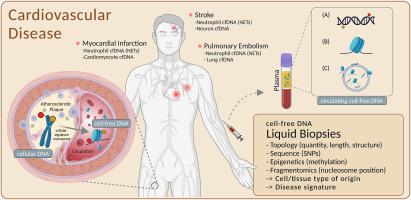心血管疾病中的核酸液体活检:心血管疾病中的无细胞 DNA 液体活检。
IF 4.9
2区 医学
Q1 CARDIAC & CARDIOVASCULAR SYSTEMS
引用次数: 0
摘要
心血管疾病(CVD)是导致全球死亡的主要原因,尽管已经进行了治疗,但心血管功能并不总能恢复,疾病的恶化也无法预防。关键的见解往往基于组织样本。目前的组织病理学知识通常依赖于侵入性活检或死后样本。液体活检通过评估循环介质来推断远处组织的组织学和病理学,在癌症研究领域进展迅速,为了解和治疗心血管疾病提供了一种前景广阔的方法。众所周知,在急性和慢性心血管疾病期间,游离细胞 DNA 的升高与疾病、严重程度有关,并具有预后价值。中性粒细胞胞外捕获物(NET)和循环核酸酶在血栓形成中的作用为在心血管疾病中进行液体活检提供了可靠的依据。cfDNA 来源于不同的组织类型和细胞来源,包括线粒体和细胞核,可用于追踪细胞和组织类型的血统,并深入了解细胞的活化状态。本文讨论了 cfDNA 的起源、结构和潜在用途,为了解心血管疾病的复杂性提供了一种更深入、创伤更小的方法。本文章由计算机程序翻译,如有差异,请以英文原文为准。

Nucleic acid liquid biopsies in cardiovascular disease: Cell-free DNA liquid biopsies in cardiovascular disease
Cardiovascular disease (CVD) is the leading cause of death worldwide, and despite treatment efforts, cardiovascular function cannot always be restored, and progression of disease be prevented. Critical insights are oftentimes based on tissue samples. Current knowledge of tissue pathology typically relies on invasive biopsies or postmortem samples. Liquid biopsies, which assess circulating mediators to deduce the histology and pathology of distant tissues, have been advancing rapidly in cancer research and offer a promising approach to be translated to the understanding and treatment of CVD. The widely understood elevations in cell-free DNA during acute and chronic cardiovascular conditions, associate with disease, severity, and offer prognostic value. The role of neutrophil extracellular traps (NETs) and circulating nucleases in thrombosis provide a solid rationale for liquid biopsies in CVD. cfDNA originates from various tissue types and cellular sources, including mitochondria and nuclei, and can be used to trace cell and tissue type lineage, as well as to gain insight into the activation status of cells. This article discusses the origin, structure, and potential utility of cfDNA, offering a deeper and less invasive approach for the understanding of the complexities of CVD.
求助全文
通过发布文献求助,成功后即可免费获取论文全文。
去求助
来源期刊

Atherosclerosis
医学-外周血管病
CiteScore
9.80
自引率
3.80%
发文量
1269
审稿时长
36 days
期刊介绍:
Atherosclerosis has an open access mirror journal Atherosclerosis: X, sharing the same aims and scope, editorial team, submission system and rigorous peer review.
Atherosclerosis brings together, from all sources, papers concerned with investigation on atherosclerosis, its risk factors and clinical manifestations. Atherosclerosis covers basic and translational, clinical and population research approaches to arterial and vascular biology and disease, as well as their risk factors including: disturbances of lipid and lipoprotein metabolism, diabetes and hypertension, thrombosis, and inflammation. The Editors are interested in original or review papers dealing with the pathogenesis, environmental, genetic and epigenetic basis, diagnosis or treatment of atherosclerosis and related diseases as well as their risk factors.
 求助内容:
求助内容: 应助结果提醒方式:
应助结果提醒方式:


